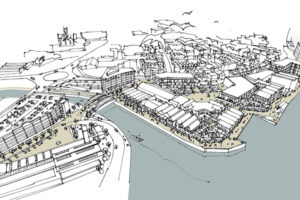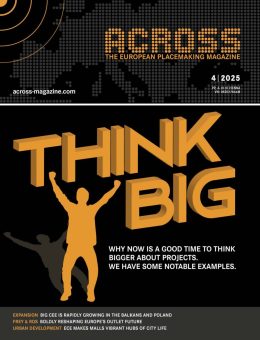ACROSS: Why was the mall — like so many things — invented in the USA?
TOM McGEE: The mall actually celebrated its 60th birthday last year. At that time, Southdale Center was built near Minneapolis. The idea of using the purchase of daily necessities as a chance to meet one other has been around much longer, however. Just think of ancient Greece’s agora or Turkey’s big bazaars.
The reason shopping centers emerged in the US in the 1950s is the migration of its population from the cities to the suburbs. Families had more living space at affordable prices and better schools. That was only possible because Americans love cars. Retail followed the people. Thus, the idea of large malls with parking areas in suburban communities fell on fertile ground.
ACROSS: Let’s jump into the present.
McGEE: The fact that the majority of people in the US live in the suburbs has not changed. There have been major demographic shifts, however, especially the population explosion of the baby boomer generation, which is now retiring. Likewise, Millennials are now driving the change in our industry. The oldest are 35. Most have yet to start a family or build a house. For shopping centers, they represent an extremely important target group.
ACROSS: To what extent has the European shopping center market evolved differently?
McGEE: This “suburban culture” does not exist in Europe. The cities have historically featured lively retail landscapes. Europe is also more densely populated. In this respect, there is a more diverse commercial real estate scene compared to the US. Nonetheless, shopping centers are also changing here—with the population and its changing or growing needs. Here, too, the Millennials act as drivers. They want experience, entertainment, and food and beverage. Since modern malls meet these requirements, I am optimistic for their future.
ACROSS: What does the future hold for the Asian shopping center market?
McGEE: It’s a huge and diverse market. What is happening in Asia is what Europe and the US already have behind them: The middle class is growing. This increases the demand for retail and thus for shopping centers.
In China, for example, malls are springing up like mushrooms. China, like India, Thailand, and the Philippines, is an emerging market. There are many exciting new developments. Others will follow. There is a lot of money flowing. Japan, on the other hand, is a relatively mature market in which growth will be more minimal.
ACROSS: What characterizes new developments in Asia?
McGEE: They are tailor-made for Asian Millennials. The focus is on entertainment and food and beverage, but traditional retail is not forgotten. These huge shopping malls fulfill community functions. They bring people together. They benefit from the fact that Asians generally like to spend a whole day with family or friends in the air-conditioned—that’s important!—malls.
ACROSS: And the Australian shopping center market?
McGEE: The population there is rising fast, in large part due to immigration. Australia currently has only 24 million inhabitants. There is potential for growth—in every respect, including retail. The possibilities are tremendous. I expect the Australian shopping center market to develop very dynamically.
ACROSS: So you are quite optimistic for the market worldwide?
McGEE: As mentioned, the most significant growth rates are in Asia’s emerging markets. There is a lot of demand there. But I’m optimistic beyond that, yes. After all, shopping is a lifestyle in Europe and in the USA. It is part of our life. It reflects on us. Of course, online commerce will continue to grow.
Retailers are facing this fact by relying on omni-channeling. Meanwhile, customers are asking for a great customer experience at fair prices. What they do not get online is the ability to touch and experience, which they value. As social creatures, they long for the emotions a mall can give them. The internet cannot provide that.
ACROSS: What global developments are affecting shopping centers the most?
McGEE: I’d like to name three. First, the demographic changes already mentioned. Millennials are becoming increasingly important to the shopping center industry. By their very nature, they have an affinity for technology, which brings me to the second point: technology—broadly speaking.
For me, for example, technology includes electromobility; it also affects our industry. The third development is people’s demand for customized information. Anyone who wants to check their stock portfolio today can do so with one click on their smartphone. Similarly, visitors to a shop or mall expect to receive personalized service.
ACROSS: What is the most exciting shopping center in the pipeline right now?
McGEE: I do not want to commit myself to an answer on that score. There are many exciting developments. They pick up on the fact that malls are not primarily about shopping, but about communities coming together.
Design and architecture are also becoming more and more of a focus. Shopping centers are becoming increasingly open, with many outdoor areas, even as the outdoor and the indoor are blending ever more harmoniously. Developers are aware of the fact that people like to be outside.
ACROSS: Will developers find it more difficult to attract retailers to their malls as tenants?
McGEE: There really is a change happening in that regard, especially in the United States at the big department storesI would not say that attracting retailers is generally becoming more difficult, however. It is more that the fight for good retailers has gotten tougher. That makes sense against the background that disruption is taking place in the industry.
That is why we have to remind people of the enormous economic importance of brick-and-mortar retail, e.g. for the number of jobs it creates and how important it is in everyday life. You sometimes have to imagine what it would be like if we did not have shopping malls.





